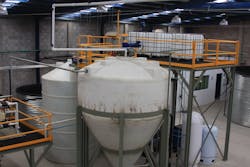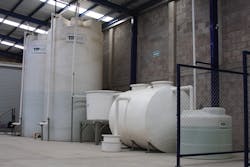About the author:
Sara Myers is associate editor for WWD. Myers can be reached at [email protected].
A 10- year partnership was the catalyst for opening an industrial wastewater treatment operation in Villa de Reyes, San Luis Potosí, Mexico. Gilberto Cifuentes, operators director at Conecsus, contacted longtime business partner Steve Butler, general director for Conecsus, about the opportunity to build a wastewater plant in Mexico.
“Since we’ve known each other for around eight to 10 years, we decided to work on the project together and propose a plan,” said Cifuentes. “Through market research and both our backgrounds, we decided to propose all the technology and develop a new company, which is one of a kind, in San Luis. We are the only ones who have the technology and permit to offer what we do right now. We proposed the project to Conecsus and they decided to invest in the project in San Luis.”
The plant was designed from the ground up by Conecsus design engineer Diana Amaro.
“She followed through on everything that was being done during the design process,” Butler said. “There were some modifications, but overall the construction of the plant was done on time. And after we received some additional information from the marketplace, we realized there were some similar equipment we needed to add.”
Conecsus is a recycling metals facility that primarily produces tin, lead, silver and antimony. The new plant is an industrial wastewater treatment plant that applies technology and a physicochemical treatment methodology to its processes for the purification of residual industrial wastewater. The plant is housed in the industrial park, Logistik II, where it neighbors manufacturing companies such as BMW, San Luis Metal Forming and Loreal.
“There are opportunities like this in both the U.S. and Mexico. Local governments and federal governments are focused on water quality more than ever; from the restaurant industry to industrial,” Butler said, noting the opportunities range from restaurants to agricultural applications. “But we have to have several technologies and different methodologies. We have an unbelievable interface in our computer system that can track all the information flowing through our plant. The type of water and laboratory analysis of the water, versus how well the water can be treated. We have a staff here very capable of doing that.”
A Different Methodology
One aspect that set the company apart was its use of physicochemical methodology during the process. Physicochemical methodology is a treatment in which coagulants and flocculants are used to treat the water, Cifuentes said.
The plant also incorporates advanced oxidation, which uses high oxidant agents to drop down the oxygen demand both chemically and organically. Through these treatment options, Conecsus can meet the legal standards for effluent quality. Choosing the correct oxidant will treat the wastewater and manage more complex waters coming from varied processes and industries. This extends to distillation.
“[We] distillate certain chemicals at different temperatures so we can recover different kinds of chemical compounds and have a treatable kind of water,” Cifuentes said. “This is used for more complex waters that have difficulty mixing with the chemicals.”
One such technique is ozone dosing. Ozone can oxidize several chemical compounds to drop organic and chemical oxygen demand to meet the local legal standards for water quality. All of the different combinations will result in a water treatment that meets the national and international standards, Cifuentes said.
The plant also houses multiple pumps and reactors to perform the reactions for water treatment and sludge treatment. This allows the company to meet standards for landfills without generating hazardous sludge.
The plant’s laboratory measures the effluent quality parameters to ensure the plant is treating it correctly. The laboratory also measures the incoming wastewater for quality changes, as well. Cifuentes said Conecsus confirms companies are sending appropriate wastewater to the plant for treatment. If the wastewater does not fit the parameters that can be treated, wastewater treatment plant officials alert the industrial companies because changes in the incoming effluent quality may suggest problems with an industrial user’s wastewater treatment process.
“The lab equipment helps us to have quality standards so our clients can keep track in case they need to improve some of the parameters that we can analyze,” Cifuentes said. “We also have an oil separation equipment consisting of special filters to separate the oil from water, and recycle the industrial oil coming from different industries and vegetable oil coming from the food industry.”
Both Butler and Cifuentes constantly envision the future of treatment. They also seek to ensure the water treated is better for the environment while also holding aspirations to expand throughout the U.S. and Mexico.


